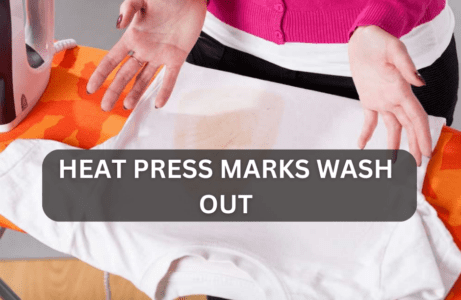Do you have garments that you’ve decorated with a heat press and are now worried about how to care for them? Do heat press marks wash out or you think the design will be damaged or ruined? If so, don’t worry. We’ll discuss if heat press marks wash out and answer any queries you may have regarding the washing of heat-pressed items.
Heat press marks on clothing can be tricky to get rid of, but with the right techniques and materials, you can easily restore your clothes to their original state. Whether you’re a fashionista, crafter, or DIY enthusiast, you know the importance of ensuring your projects look as good as possible.
You’re not alone if you’ve ever felt a little worried while washing your favorite shirt or apron with a heat press logo. Many worry that their design or logo painstakingly created won’t survive the washer and dryer.
Let’s get started.
Do Heat Press Marks Wash Out
Heat press marks are a common decoration on clothing, hats, and other accessories. But one question many people ask is whether these heat press marks will withstand the test of time and washing. The answer to this question depends on the type of garment being decorated and the method for applying the heat press mark.
Regarding fabric items, such as t-shirts, most heat presses today use a combination of pressure and heat to transfer an image onto a garment. The result is a durable image that can withstand multiple washes without fading or washing out.
However, certain fabrics may not be suited for this process and could experience some loss in color or distortion over time. If the user does not follow proper procedures when applying their design, it could lead to cracking or peeling due to improper curing techniques.
Types of Heat Press Marks
There are several different types of heat press marks, including:
1. Ghosting
This type of mark is caused by uneven pressure on the press and results in a faint, translucent image of the design on the garment.
2. Blistering
Due to trapped air and heat between the garment and the heat platen, resulting in bubbles or blisters on the design.
3. Shine
It is caused by the heat press being set to a temperature that is too high and results in a shiny, glossy appearance on the garment.
4. Scorching
If the heat press is set to a temperature that is too high, the fabric is burned or discolored.
5. Dye migration
It is caused by the heat press being set to a temperature that is too high, and the result will be the dye getting bled out or discoloring the fabric.
6. Distortion
The design is stretched, compressed, or distorted due to press time and pressure not being adjusted accordingly.
Preventing these types of heat press marks can be done by properly adjusting the heat press settings and pressure, using a protective covering, and testing the press on a scrap piece of fabric before using it on a final product.
Materials Affected by Heat Pressing
The effects of heat pressing will vary depending on the type of material and the temperature and pressure used during the process. Some materials that may be affected by heat pressing include:
1. Fabrics
Cotton, polyester, and other natural and synthetic fabrics can be heat pressed, but they may shrink, stretch, or become discolored if the temperature and pressure are not properly adjusted. The heat may damage delicate fabrics, such as silk or lace.
2. Plastics
Some plastics, such as PVC, can be heat pressed, but they may become deformed or discolored if the temperature and pressure are not properly adjusted. Some plastics may emit toxic fumes when heated, so care must be taken when heat pressing these materials.
3. Metals
Metals such as aluminum, steel, or titanium can be heat pressed, but they may lose some of their strength and rigidity if the temperature and pressure are too high.
4. Paper and Cardboard
These materials may get singed, wrinkled, or deformed if heat pressed; also, the ink on them may get smudged or run.
It is essential to be familiar with the characteristics of the material you are working with and adjust the heat press settings and pressure accordingly. If you are still determining if a particular material can be heat pressed, it is always best to test it on a scrap piece before using it on a final product.
How to Avoid Heat Press Marks
Here are some steps you can take to avoid heat press marks when using a heat press:
1. Adjust the temperature and pressure
Ensure the heat press is set to the appropriate temperature and pressure for the material you are working with. It is better to start with a lower temperature and gradually increase it rather than starting with a high temperature and risking scorching or other marks on the material.
2. Use a protective covering
Use a Teflon sheet or other protective covering over the design to prevent marks caused by uneven pressure on the press.
3. Test on a scrap piece
Before using the heat press on a final product, test it on a scrap piece of the same material to ensure that the temperature and pressure settings are correct. It also allows checking for issues like dye migration and heat press marks.
4. Place the design correctly
Be sure to place the design in the correct position on the garment or other item before pressing to avoid marks caused by stretching or distorting the design.
5. Avoid overlapping
Avoid overlapping the design or the protective covering, as this can cause marks caused by uneven pressure on the press.
6. Monitor the press
Keep an eye on the press while it’s running, and remove the garment or other item as soon as the recommended pressing time is up, to prevent marks caused by over-pressing.
Following these steps, you can help ensure that your heat-pressing project looks professional and polished without any unsightly marks or discolorations.
Conclusion
The conclusion of the article “Do Heat Press Marks Wash Out?” is an affirmative yes. With proper care and maintenance, heat press marks can be easily removed from apparel. First, the best method of removing heat press marks is to try warm water and a mild soap solution. If that fails, then use an apparel-safe spot remover or detergent.
It’s important to note that a good quality heat transfer paper can help reduce the residue left on the fabric after pressing. Using a protective sheet over the paper can also help prevent some types of imprints from occurring in the first place.

I’m Henry Collins and living my happy life. I’m a professional businessman and I own and run 6 Heat Pressing Services stores where I provide my clients with custom Designs on hats, mugs, T-Shirts and a lot more using Heat Press Machine. Been using a heat press for the last 4 years and people love my work. As I’ve got enough information on Heat Press I decided to make a blog on it and share my knowledge with the world. I hope, the world will appreciate it.

